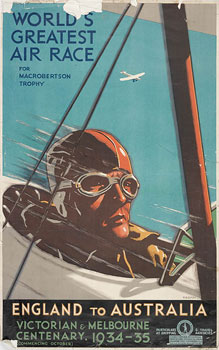Crossing oceans
With a view to further stimulating local aerial activity, in 1919 the Commonwealth Government announced a prize of £10,000 for the first Australian to fly from England to Australia. Ross and Keith Smith, flying a Vickers Vimy, claimed the prize when they landed in Darwin, NT, after nearly 136 hours flying time over 28 days.
In 1924 the first aerial circumnavigation of Australia was completed by Goble and McIntyre, who took 44 days to fly a seaplane around Australia, due to bad weather and mechanical failure.
By 1927, this time had been vastly reduced when Charles Kingsford Smith and Chalres Ulm flew a Bristol Tourer around the country in just ten days. Kingsford Smith and Ulm went onto further glory the following year, with Americans Harry Lyon and James Warner, by completing the first trans-Pacific crossing. They undertook this hazardous and eventful journey in a Fokker trimotor, the Southern Cross, in 83 hours of flying time, landing in Sydney on 10 June 1928.
A similarly heroic achievement that year was that of Queenslander Bert Hinkler who embarked on the first solo flight to Australia, taking off from Croydon, England, and arriving in Darwin on 28 February 1928 after 128 hours of flying time.
World's Greatest Air Race, 1934
Poster POSTERS 1006
In 1934, the Victorian government organised an air race from London to Melbourne to celebrate the southern city's centenary. Sponsored by Sir MacPherson Robertson it became known as the MacRobertson Air Race. With a prize of £15,000 there were initially 64 entrants from 13 countries, though by the time the race started this had fallen to just 20 entrants from seven countries.



